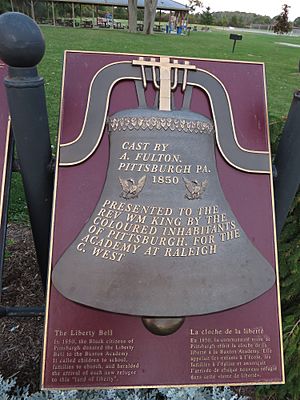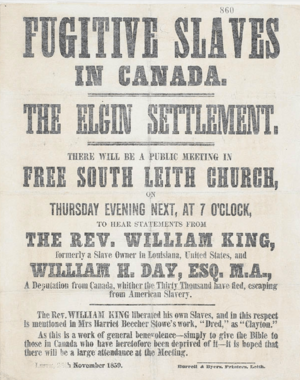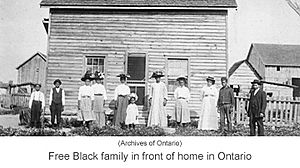Black Canadians in Ontario facts for kids

Black Canadians are people of African descent who live in Canada. Many of them came to Canada in the 1700s and 1800s from the United States. A lot of these people found freedom by traveling north through a secret network called the Underground Railroad. They settled in places like Southwestern Ontario, Toronto, and Owen Sound. Black Canadians also played an important role in history, fighting for the British in the War of 1812 and the Rebellions of 1837–1838. Some even returned to the United States later, during the American Civil War or the Reconstruction era.
Contents
Early Arrivals in Canada
Many enslaved African Americans came to what was then British North America (now Canada) after 1793. That year, a law called the Act Against Slavery was passed. This law said that enslaved people would become free as soon as they entered Canada. It also made it illegal to bring new enslaved people into the country. Children born to enslaved parents would become free when they turned 25.
News spread in the United States that British North America had free Black soldiers who fought in the War of 1812. This encouraged more African Americans to move there. Some Black people were brought to what is now Ontario as enslaved people by Loyalists. These Loyalists settled in Upper Canada after 1812. They made their homes along the Detroit River, Niagara River, and Saint Lawrence River.
Freedom for All
In 1819, John Beverley Robinson, who was the Attorney General, ordered that all Black residents in Upper Canada be freed. This was a big step towards freedom. Then, in 1833, slavery was completely ended across the entire British Empire. This act freed nearly one million people around the world.
The Underground Railroad
The Underground Railroad started in Philadelphia in the early 1800s. It was a secret network of people who wanted to help enslaved individuals escape to freedom. These helpers worked secretly to guide people seeking freedom into the Northern United States (which were "free states") or even further north into what is now Canada.
People seeking freedom were helped on their journey by other enslaved people, free Black individuals, Quakers, and other people who wanted to end slavery, called abolitionists. For example, Jermain Wesley Loguen found freedom in what is now Ontario. He lived in Hamilton and St. Catharines from 1837 to 1841. Later, he moved to Syracuse, New York, where he ran an Underground Railroad station.
A large number of Black people came to Canada after the Fugitive Slave Act of 1850 was passed in the United States. This law made it easier for people to capture and return enslaved individuals. Because of this, many people seeking freedom planned to settle in what is now Ontario. Sometimes, bounty hunters would even come into Canada to try and capture formerly enslaved people for a reward.
One example happened in Chatham. A former slaveholder tried to take Joseph Alexander, who had been enslaved by him. But Black community members and Alexander himself spoke up. The crowd refused to let Alexander be taken. The slaveholder left Chatham without Alexander, who remained free. You can learn more about this in the article about the Chatham Vigilance Committee.
New Communities and Settlements
During the American Revolutionary War, Black Loyalists and other people seeking freedom escaped to Canada. They created new homes in Toronto, Owen Sound, and various places in Southwestern Ontario. These included cities like London, Chatham, Amherstburg, Oro, Ontario, and Windsor. They also settled in Sandwich (which is now part of Windsor), Niagara Falls, Hamilton, Buxton, Brantford, and Oakville. Some people also found refuge in Quebec, Nova Scotia, and New Brunswick.
One important settlement was the Wilberforce Settlement. It was started in 1830 near Lucan by African Americans from Cincinnati. They came to Canada because of "Black Codes" in the US. These laws treated Black people differently and unfairly compared to white people. However, by 1836, problems with how the settlement was managed caused it to break down.
Josiah Henson came to Canada with his wife and four children. In 1841, they founded the Dawn settlement in a rural area near Dresden. The people in this settlement worked together to help each other, sharing their skills. They farmed, ran mills for grinding grain and cutting wood, and started businesses like making rope and bricks. The British American Institute was a school there that taught both traditional subjects and job skills.
Another important community was the Elgin settlement. It was founded at Buxton near Chatham in 1849. It was started by Rev. William King, who had once owned enslaved people. He brought 15 of his former enslaved people with him. King was a Presbyterian minister who settled in southern Ontario. The Buxton settlement became very famous for its excellent school. By the 1860s, about 2,000 people lived there. Another all-Black community in Ontario was called Queen's Bush.
African Canadians built farms, worked, and started many businesses. These included blacksmith shops, places to rent horses and carriages, carpentry businesses, grocery stores, clothing shops, and pharmacies. They built strong communities with their own schools, churches, newspapers, and groups that helped people in need.
Fighting Against Slavery
Henry Bibb and his wife Mary started a newspaper called The Voice of the Fugitive in 1851 in Windsor. This newspaper was against slavery and reported on the activities of the Underground Railroad. Mary Ann Shadd, who was the first Black female publisher and newspaper owner in Canada, and her brother Isaac Shadd founded The Provincial Freeman in 1853. It became a weekly newspaper published out of Toronto in 1854, and later from Chatham.
In 1851, Black and white people together formed the Anti-Slavery Society of Canada in Toronto. This group worked to teach others about the horrors of slavery and to help Black people who were seeking freedom.
Military Service
In Canada

Black Canadians volunteered and fought during the War of 1812. They wanted to protect their new country and make sure they would not be sent back to slavery in the United States. For their service, Lieutenant Governor Sir Peregrine Maitland gave many Black individuals land in Oro Township in 1815. However, the land was not good for farming, so they did not stay there. During the Rebellions of 1837–1838, they served in separate "Colored Corps" units. They fought to protect the rights of African Canadians and to defend the government.
American Civil War
Almost 1,000 Black Canadians joined the Union Army during the American Civil War (1861–1865). African Americans were declared free by the Emancipation Proclamation. Slavery was officially ended in the United States by the Thirteenth Amendment to the Constitution in 1865. Some Black individuals returned to the United States from Canada during the Reconstruction era.
In Popular Culture
- The documentary The North Star: Finding Black Mecca was filmed in Chatham, Dresden, and Buxton.
See also



